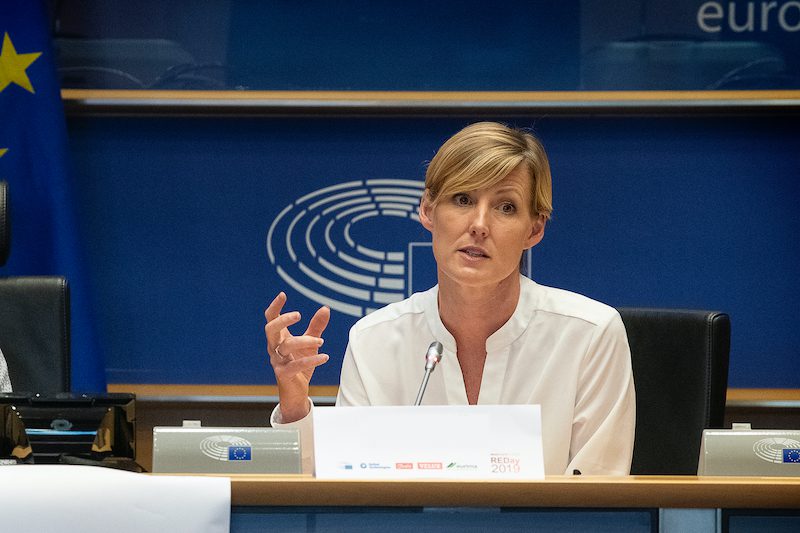By Chris Grundler, Senior Advisor to the Crux Alliance, and former Director of the Office of Transportation and Air Quality at the Environmental Protection Agency.
Two recent events suggest the world may finally be coming to grips with the urgent need to cut harmful climate pollution from buildings. On March 7 and 8, 2024, 1,400 participants from around the world gathered at the first-ever Buildings and Climate Global Forum hosted by the French government and the United Nations Environment Programme. The Forum resulted in the historic Declaration de Chaillot, with 70 countries committing to take concrete steps to achieve carbon-neutral buildings.
And the following week, after years of development and consultation, the European Parliament voted to approve Europe’s new Energy Performance of Buildings Directive. Experts from Crux Alliance members Regulatory Assistance Project (RAP) and Global Buildings Performance Network (GBPN) contributed to both of these momentous feats.
According to the latest UN Environment Programme report, buildings consume 34 percent of the energy used by humans and contribute 37 percent of the greenhouse gas emissions heating the planet. To stabilize the climate, countries must urgently transition away from harmful fossil fuels and toward clean and renewable energy to power, heat, and cool all buildings.
In addition to cutting harmful emissions, sustainable buildings can improve quality of life, especially for people living in older or substandard housing. For example, more efficient buildings reduce energy bills and keep people warmer in the winter and cooler in the summer. Significantly, both the Declaration and the Directive recognize the need to transform how we design buildings so they also protect people’s health and bolster resilience in a changing climate, especially for the most vulnerable populations.
A global commitment to climate-friendly buildings
The Buildings and Climate Global Forum brought together government ministers and high-level representatives from organizations involved in every aspect of the buildings sector, as well as experts and representatives from civil society, with the goal of initiating new international collaboration to accelerate building decarbonization. The resulting Declaration creates the first international framework for decarbonizing the buildings sector, outlining both a set of common principles to align the sector with the Paris Agreement and a commitment to specific strategies and policies.

GBPN experts served on the advisory group responsible for establishing and implementing the Forum agenda and helped draft the Declaration text. As the author of the UN Guide to Incorporating Buildings Actions in NDCs and a technical partner to the UN Environment Programme zero-emission roadmap program, GBPN was invited to contribute to a high-level panel on nationally determined contributions and zero-emission roadmaps. GBPN’s Africa Lead, Mugure Njendu, also presented recent work on health and just transitions at the Forum. Importantly, the Declaration commits to “develop integrated urban planning policies aiming at greater resilience, efficiency, and sufficiency for all buildings, urban spaces, neighbourhoods and inhabitants at all levels.” This attention to both sufficient and resilient buildings is critical to ensuring new policies promote safe, adequate buildings that protect inhabitants’ health and well-being.
In reflecting on the outcome, Dr. Peter Graham, Executive Director of GBPN, commented, “The Declaration is significant because ministers recognize that progress on decarbonizing the built environment is not sufficient to keep global warming below 1.5 degrees. By implication this reaffirms a commitment to limit global warming to 1.5°C.”
In addition, Dr. Graham shared his thoughts on next steps, remarking, “The Declaration is a good start, but we have more work to do to see these commitments achieved and all countries come on board. There is very little representation of South and Southeast Asian countries among the signatories. As GBPN supports climate policy for buildings in these countries, we know that they have significant progress to share, and can take leadership roles in their regions.”
Cutting climate pollution from Europe’s buildings
Meanwhile, in Brussels, the European Parliament adopted the landmark new Energy Performance of Buildings Directive, which aims to cut all planet-heating carbon emissions from the EU buildings sector by 2050. The Directive requires that new residential and non-residential buildings generate no on-site carbon emissions from fossil fuels by 2030, making zero-emission buildings the standard for all new construction.
To tackle the greater challenge of retrofitting existing buildings, the Directive treats residential and non-residential buildings differently. For residential buildings, the Directive requires an average 16 percent reduction in primary energy use across all existing buildings by 2030 and 20-22 percent by 2035. However, each member state may adopt its own policy approach to reach these targets. To deliver greater social benefits and accelerate reductions in climate pollution, national measures must also target renovation of the worst-performing buildings, where lower-income households disproportionately live.
For non-residential buildings, the Directive introduces minimum energy performance standards for all buildings, but also requires improvements in the least efficient 16 percent of buildings so they no longer will be in this worst-performing group by 2030. The standards will expand to cover the least-efficient 26 percent of buildings by 2033. The renovation requirements are complemented by enabling measures such as strengthened financial support and improved access to advice. The Directive also contains provisions to roll out new building-level energy infrastructure, including requirements to deploy solar energy installations on all suitable new and some existing buildings, and to prepare buildings for electric vehicle charging.

Louise Sunderland, a managing principal for RAP in Europe and an expert on demand-side energy policies and energy justice, was engaged in the development of the Directive from the outset. Prior to the proposal, RAP undertook extensive work on the central renovation measure—the minimum energy performance standards—helping make a little-known policy part of the regulatory lexicon. RAP’s analysis also made the case for the enabling framework of financial support, practical help, and safeguards. Then, experts at RAP offered specific design options for the EU legislative framework. During the negotiations, Louise provided on-the-spot technical advice to negotiators on the complex and frequently changing proposals.
Louise remarked about the new Directive: “This has been a four-year journey, and each step has been challenging. However, we achieved significant new provisions on several fronts: new buildings will no longer emit on-site emissions; we have an end to subsidies for stand-alone fossil fuel boilers; national plans to decarbonize heating and cooling by 2040; minimum energy performance standards for non-residential buildings—the list goes on.”
In addition, Louise noted the emphasis on equity: “Looking across the whole package of new EU climate legislation, there is significantly more focus than ever before on measures to ensure that the benefits of energy efficiency and renewables reach lower-income households and people at risk of energy poverty. In the Buildings Directive, the requirement to focus renovation on the worst-performing buildings directs efforts to those who most need them. This is supported by a requirement to prioritize public funds and financial incentives to support these households and provide dedicated advice services through one-stop-shops. While there is much more work to do, these measures show a clear direction of travel. The spotlight now will be on effective implementation at national and local levels.”
Critical role of Crux Alliance
Both of these milestones—the Declaration and the Directive—represent significant progress. And the stakes are enormous. When it comes to building decarbonization, there is no time to lose, particularly given the ongoing growth of the Global South economies. The know-how, technologies, and best practices exist—they just need to be implemented. This is where Crux Alliance members like RAP and GBPN are making a difference for people and planet. It’s crucial the world gets this right.
